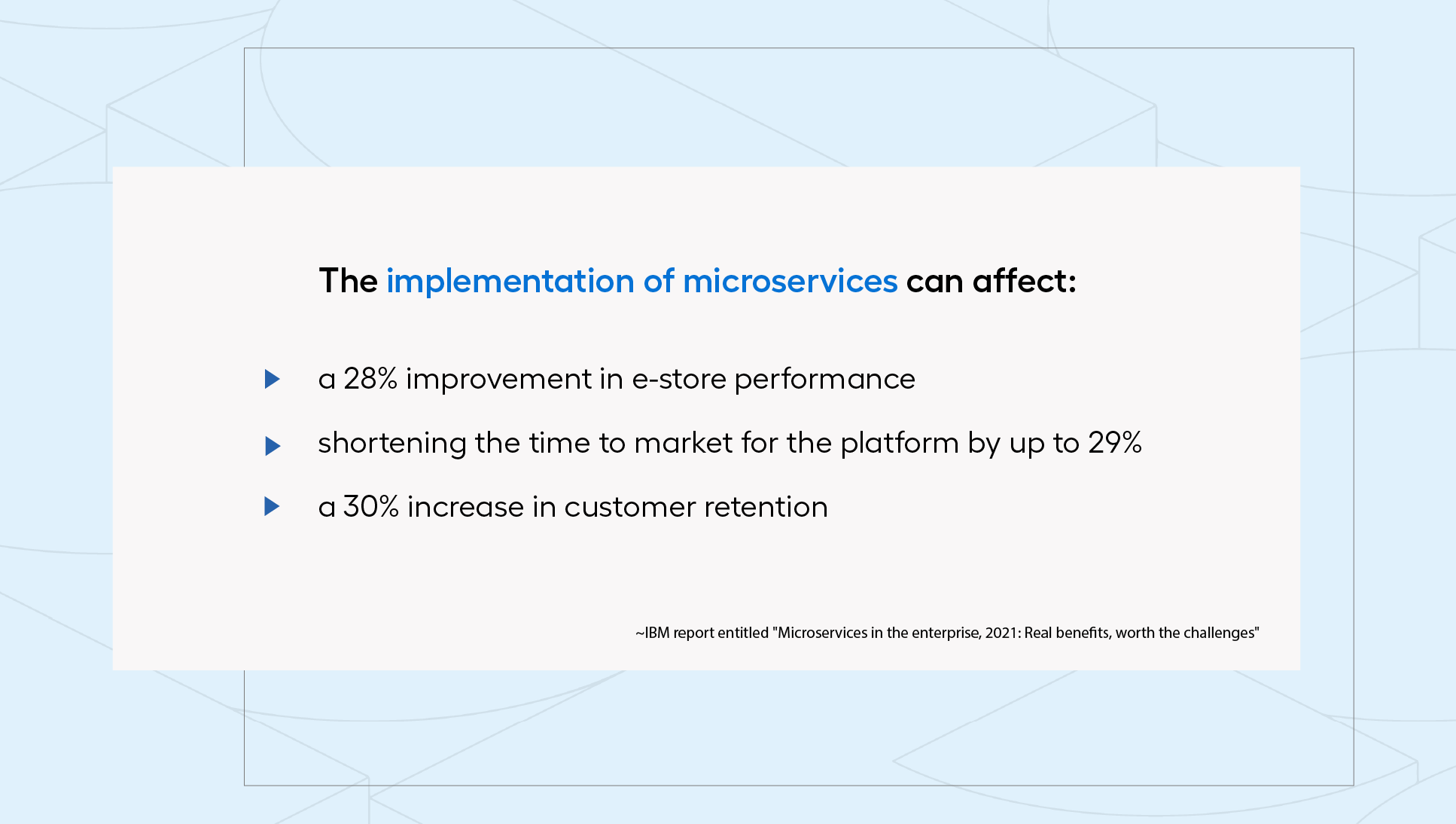Table of contents
- Microservices - what are they?
- A few words about APIs, or how microservices connect?
- How to use microservices in an online store?
- Are microservices and Magento a good combination?
- Microservices in practice - what does the implementation of microservice architecture look like?
- Microservices - are they worth the hype?
- An online store on microservices - is this what the future of the industry will look like
- high versatility in system creation - the ability to use different programming languages and independence from a single provider.
- independence of individual services - greater flexibility and ease of managing individual areas in the e-store.
- scalability - the ability to expand, change, and update individual systems as needed (e.g., in the face of increasing traffic or decisions to sell in new markets).
- fault tolerance- thanks to separate databases and isolation of individual services, downtime of the entire system in case of failure is avoided. Additionally, diagnosing and repairing faults is easier, resulting in greater system reliability.
- Requirements analysis and architecture design - the first step is a thorough analysis of business and technical requirements. Based on this, the team designs microservices architecture. It determines which functionalities will be performed by individual services and how they will communicate with each other.
- Microservices implementation - during the implementation of microservices, containerization tools such as Docker are often used, which allows for isolation and easy movement of applications between different environments. In addition, to manage containers and automate processes, developers often use tools such as Kubernetes or Docker Swarm.
- Testing and monitoring - after implementing services, integration tests are carried out to ensure that all components work correctly together. Then, the architecture is optimised by removing unnecessary dependencies and optimising system performance. At this stage, tools such as Prometheus or Grafana (for real-time performance monitoring) are used.
- Monitoring - after successful testing, microservices are deployed to production. Then their operation is monitored, responding to any issues and optimising system performance as needed. Tools for Continuous Integration/Continuous Deployment (CI/CD), such as Jenkins, GitLab CI/CD, or CircleCI, can be used to automate deployment processes and manage the production environment.
When designing an online store, you must take into account many aspects - you are surely wondering how to make it not only functional at the time of implementation but also ready for future challenges. Opting for microservices architecture can provide just that. Thanks to microservices, an online store can be built modularly, ensuring more efficient resource management, greater scalability, and better response to changes in the market environment. Find out how you can implement microservices in your e-store. Learn about the possibilities of combining them with well-known platforms like Magento. And also check what tools are used in the entire process. It's all waiting for you in this article.
Microservices - what are they?
What are microservices? To understand the essence of this concept, it is worth resorting to simple associations. Think of a car factory, where instead of one production line, where the whole car is produced, the work is divided into several separate lines. In each department, individual elements of the vehicle - the engine, electrical system, body - are produced independently. When one of the lines stops working, the others can continue to work, minimizing delays and avoiding paralysis of the entire factory. Such organization of work guarantees production stability and achievement of set goals. Microservices work on the same principle.
Microservices architecture is an approach to building and managing IT systems in which the whole is divided into smaller, autonomous components. Each of these components, called microservices, is responsible for performing a specific function or service. Thanks to breaking down the system into smaller parts, the platform becomes more flexible and easier to adapt to changing business requirements. This approach is particularly desirable when the number and complexity of platform functions increase. It optimises development processes, allowing work on different parts of the system simultaneously and minimising the risk of changes.
A few words about APIs, or how microservices connect?
In microservices, resources are distributed - individual pieces of information are enclosed in separate segments (microservices). Moreover, each of them is usually assigned separate databases, which allows the independence of individual services from each other. Service isolation promotes fault tolerance and enables scaling of each component independently. However, for these distributed microservices to cooperate effectively, there must be a consistent way of communication between them. How is this connection achieved?
This is where API (Application Programming Interface) comes in. These interfaces provide the connection between individual microservices, enabling communication and data exchange. The API defines the rules and regulations for how services can communicate with each other. Thanks to this, microservices can work together efficiently and seamlessly, even if they are written in different programming languages or use different technologies. Importantly, APIs enable both synchronous communication (where systems exchange information at specified times) and asynchronous communication, where data processing can take place in the background. This approach facilitates smooth operation in environments where there may be many data sources in the queue for querying, exactly as in the case of microservices.
In practice, different types of APIs are often used in microservices architecture, tailored to specific project needs and requirements. These can include RESTful API, GraphQL, or SOAP, depending on preferences and the nature of communication between services.
How to use microservices in an online store?
Microservices can be successfully implemented in online stores. This is facilitated by the structure of sales platforms, which can be easily divided into different areas (microservices), such as product information management, customer relations, payments, or deliveries.
Depending on the specific needs and project specifics, microservices can constitute both a central part of the online store and only a fragment of it. In the case of coexistence with other architectures, such as monolithic, where all functionalities are contained within one system, microservices create a hybrid environment. In summary, from the perspective of eCommerce, the main advantages of microservices include:
Are microservices and Magento a good combination?
Running an online store sooner or later, you will face the need to introduce improvements on your platform. Various aspects of your business may develop at different tempos. In some areas, there may be a need to implement more advanced integrations with external services. At such a moment, you need to consider how to expand your platform to meet the dynamic business development.
In the case of Magento, you have several options to choose from. You can consider using ready-made solutions (plugins available within the extensive Magento library). In this case, you must bear in mind that such a solution may not meet all of your individual needs (due to its focus on a wide audience). Another option is to commission the development of new functionalities from scratch - while this solution often turns out to be more time-consuming, it can be more cost-effective in the long run. Investing in a personalised solution may ultimately be the most optimal due to greater flexibility and scalability.
However, there is another alternative that combines the advantages of both approaches mentioned above - microservices. Thanks to them, you can modularly expand your platform, adapting it exactly to your needs, while maintaining flexibility and scalability. With microservices, you can customize your platform to your individual needs. What's more, microservices enable easier project management by working on different parts of the system simultaneously, which shortens the implementation time. This way, you can quickly respond to growing customer expectations. As a result, your eCommerce platform can be not only more competitive but also more flexible and prepared for future market challenges.
Microservices in practice - what does the implementation of microservice architecture look like?
The biggest challenge in implementing microservices is thoughtfully designing server (or system) architecture. Poorly designed microservice schemas can bring results contrary to those intended. For example, components that are not properly communicated with each other may encounter performance issues. Similarly, too much fragmentation of the entire system into individual microservices can lead to excessive complexity and overload of the system. This can manifest itself, for example, in difficulties in quickly and efficiently implementing changes. Therefore, to ensure that the platform's foundations are solid, it is worth entrusting this task to experienced DevOps developer teams. They will help select and customise tools that will ensure stable platform operation in a decentralised environment. How exactly does the design process proceed?
Microservices - are they worth the hype?
The concept of microservices brings numerous benefits that make them an attractive option for various organisations. Nevertheless, there is still a belief that such a model is dedicated only to large enterprises with complex structures using large datasets. This is primarily due to the fact that the popularity of microservices has increased due to their promotion by large corporations such as Netflix, Uber, or Amazon. Although indeed - microservices can be particularly beneficial in terms of optimising and scaling infrastructure, their implementation can be beneficial for companies of various levels of development and scale of operation. As reported by IBM, companies that have opted for microservices have seen a significant improvement in e-store performance and increased customer retention. This decision also contributed to shortening the time to market for the platform.

However, does this mean that microservices will work for every online business? There are situations where the use of microservices may be impractical or even impossible to implement, especially if the online store has a simple structure and a small number of services. In such cases, excessive division into microservices may lead to unnecessary complication of the system architecture, which in turn may be ineffective and lead to excessive maintenance costs.
Therefore, before deciding to implement microservices, it is necessary to carefully examine the specifics and needs of your own business to assess whether such architecture is the right solution.
| When is it worth betting on microservices? | When might microservices be a bad investment? |
|---|---|
| When an eCommerce platform is growing rapidly, and the need to expand and modify functionality is frequent. | When there is a risk of excessive fragmentation and complexity of the system, which may lead to loss of efficiency and excessive maintenance costs (e.g., an online store has a simple structure and a small number of services) |
| When there is a need to quickly implement new functionality and shorten time to market. | When an online store does not anticipate significant expansion in the future. |
| When a company seeks to become independent of a single technology vendor through a modular approach to platform expansion. | When a company does not have sufficient financial or human resources to successfully implement and maintain a microservices architecture. |
An online store on microservices - is this what the future of the industry will look like?
Microservices offer a range of benefits that make them an attractive option for many online businesses, regardless of their size or industry. They enable easier and more efficient creation, implementation, and development of the platform, which is crucial in the face of dynamic development and evolving business needs. However, it is worth remembering that microservices are not a universal solution to all challenges and business needs. The key is to adjust the architecture to the specific situation and context to ensure optimal store performance in the long term. Wondering how you can use microservices in your business? We are happy to help you discover the full potential of microservices.







